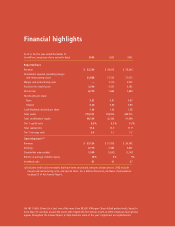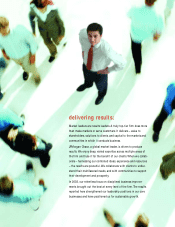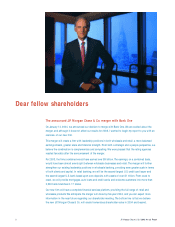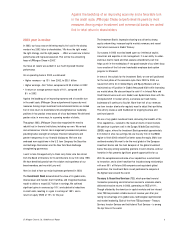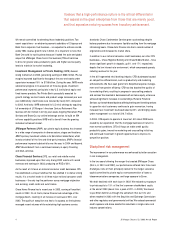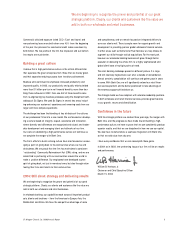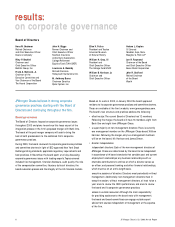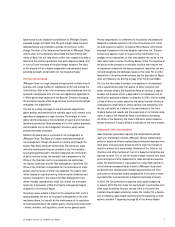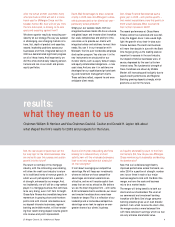JP Morgan Chase 2003 Annual Report Download - page 6
Download and view the complete annual report
Please find page 6 of the 2003 JP Morgan Chase annual report below. You can navigate through the pages in the report by either clicking on the pages listed below, or by using the keyword search tool below to find specific information within the annual report.
4J.P. Morgan Chase & Co. / 2003 Annual Report
I believe that a high-performance culture is the critical differentiator
that separates the great enterprises from those that are merely good,
and that separates enduring success from transitory achievement.
We remain committed to extending those leadership positions. Two
recent acquisitions – an electronic payments subsidiary of Citigroup and
Bank One’s corporate trust business – are expected to enhance consid-
erably TSS’s revenue growth rate in 2004. (It is important to note that
Bank One sold its trust business because it lacked the scale and global
scope that JPMorgan Chase has in this business.) TSS will continue
to drive for greater scale, productivity gains and higher service quality
levels to maintain its market leadership.
Investment M anagement & Private Banking (IMPB) showed
strong momentum in 2003, generating earnings of $268 million. Pre-tax
margins improved significantly throughout the year and assets under
supervision increased 18% to $758 billion. During the year, IMPB made
substantial progress in its execution on three key goals. Investment
performance improved, particularly in key U.S. institutional equity and
fixed income products. The Private Bank successfully executed its
growth strategy as client assets and product usage increased year over
year. Additionally, credit costs were lowered by nearly 60% compared
to 2002. And lastly, IMPB advanced its U.S. retail strategy by acquiring
full ownership of J.P. Morgan | American Century Retirement Plan
Services with $41 billion in 401(k) plan assets. Aligning Retirement Plan
Services and BrownCo, our online brokerage service, to build an IRA
roll-over capability positions IMPB well to benefit from the growing
individual retirement market.
JPMorgan Partners (JPMP), our private equity business, has invested
in a wide range of companies in diverse sectors, stages and locations.
JPMP’s primary investment vehicle is its $6.5 billion Global Fund, which
invests on behalf of the firm and third-party investors. JPMP’s financial
performance improved substantially over the year. In 2004 and beyond,
JPMP should benefit from a continued recovery in equity financing
and M&A activities.
Chase Financial Services (CFS), our retail and middle market
businesses, improved upon their very strong 2002 results with record
revenues and earnings in 2003, producing an ROE of 28% .
As the result of its focus on national consumer credit businesses, CFS
has established a unique franchise that has enabled it to deliver strong
results. It is a market leader in all three major national consumer credit
businesses – the only top-five performer across mortgage origination
and servicing, credit cards and auto finance.
Chase Home Finance had a record year in 2003, coming off excellent
results in 2002. On all fronts, Home Finance took advantage of the
mortgage boom, resulting in an increase in revenues of 38% over
2002. The quality of execution was key to its success, as the business
managed record volumes while maintaining high customer service
standards. Chase Cardmember Services grew outstandings despite
balance paydowns due to consumer liquidity resulting from the mortgage
refinancing boom. Chase Auto Finance also had a record number of
originations and increased its market share.
In addition to our national consumer credit businesses, our other CFS
businesses – Chase Regional Banking and Chase Middle Market – have
shown significant growth in deposits, up 8% and 17% respectively,
despite the low interest rate environment, which compressed spreads,
reducing revenue for the year.
In the still fragmented retail banking industry, CFS’s businesses focused
on competitive differentiators, such as productivity and marketing
enhancements. We have seen gains from disciplined expense manage-
ment and from greater efficiency. CFS has also boosted the quality of
its marketing efforts, resulting in progress in cross-selling products
and services. We invested in businesses such as home equity, where we
achieved significant increases in outstandings. Personal Financial
Services, our branch-based business offering banking and investing services
to upper-tier retail customers, continues to gain momentum, having
increased new investment fee-based sales by 63% and bringing assets
under management to a total of $10.7 billion.
In 2004, CFS expects to operate at lower but still robust ROE levels,
caused by our expectation that the mortgage business will return to
more normal conditions. CFS will focus on stable credit quality,
productivity gains, innovative marketing and cross-selling initiatives,
and continued investment in growth opportunities to improve its
competitive position.
Disciplined risk management
The improvement in our performance was enhanced by better execution
in risk management.
In the two years following the merger that created JPMorgan Chase
(that is, in 2001 and 2002), our performance suffered from three main
challenges, none of them principally related to the merger: excessive
capital committed to private equity; over-concentration of loans to
telecommunications companies; and large exposure to Enron.
We dealt decisively with each issue in 2003. We reduced our exposure
to private equity to 15% of the firm’s common stockholders’ equity
at the end of 2003 (down from a peak of 29% in 2000). We moved
to put Enron behind us through the settlement that our firm and
others reached in 2003 with the Securities and Exchange Commission
and other regulatory and governmental entities. We reduced commercial
credit exposure and drove substantial reductions in single-name and
industry concentrations.


